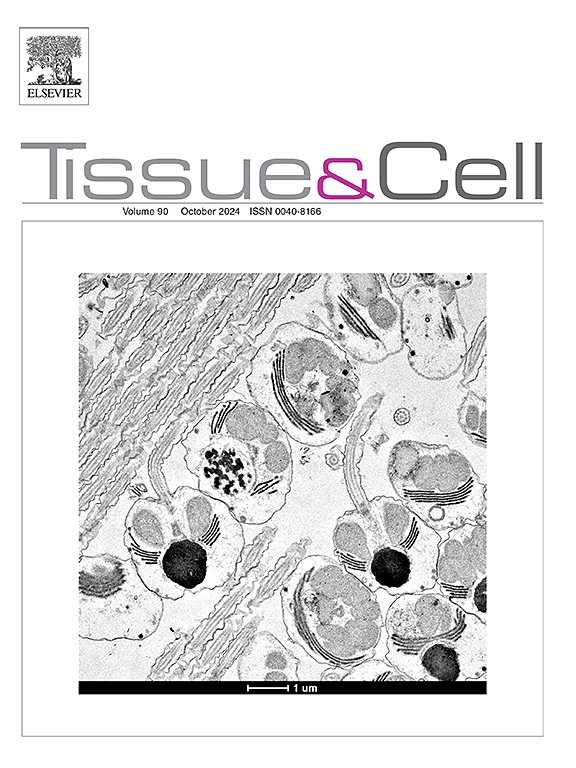Pro-apoptotic and mitochondria-disrupting effects of 4-methylthiazole in K562 leukemia cells: A mechanistic investigation
IF 2.7
4区 生物学
Q1 ANATOMY & MORPHOLOGY
引用次数: 0
Abstract
Thiazole derivatives have garnered attention for their anticancer potential. This study investigates the antileukemic effects of 4-methylthiazole on K562 chronic myeloid leukemia (CML) cells, focusing on apoptosis induction and mitochondrial dysfunction. Cell viability was assessed using MTS assays; apoptosis and necrosis were analyzed via Annexin V/PI staining and flow cytometry; mitochondrial membrane potential changes were evaluated with JC-1 dye; gene expression levels were measured by qRT-PCR; and levels of apoptosis- and cytokine-related proteins were quantified using ELISA. Treatment with 4-methylthiazole led to selective cytotoxicity in K562 cells while sparing healthy peripheral blood mononuclear cells (PBMNCs). Apoptotic induction was evidenced by Caspase-3 (CASP-3) activation, Cytochrome-C (CYT-C), release, and mitochondrial depolarization. Gene expression analysis showed upregulation of pro-apoptotic markers such as TP53 (tumor suppressor protein 53), BAX and BAK (pro-apoptotic Bcl-2 family proteins), while upregulation of CASP3 (caspase-3) expression was not statistically significant. Conversely, levels of GPX4 (glutathione peroxidase 4, involved in oxidative stress protection) remained unchanged, indicating an apoptosis mechanism independent of oxidative stress. Additionally, SEMA3A (Semaphorin 3 A, involved in tumor progression and cell signaling) was significantly downregulated. Cytokine profiling revealed a dose-dependent modulation of IL-6, while TNF-α and IL-10 levels remained unaffected. These findings suggest that 4-methylthiazole induces apoptosis through mitochondrial pathways, affects cytokine signaling, and selectively targets leukemia cells, supporting its potential as a therapeutic candidate for CML treatment.
4-甲基噻唑在K562白血病细胞中的促凋亡和线粒体破坏作用:机制研究
噻唑衍生物因其抗癌潜力而受到关注。本研究探讨4-甲基噻唑对K562慢性髓性白血病(CML)细胞的抗白血病作用,重点关注凋亡诱导和线粒体功能障碍。采用MTS法测定细胞活力;Annexin V/PI染色和流式细胞术分析细胞凋亡和坏死;JC-1染色评价线粒体膜电位变化;采用qRT-PCR检测基因表达水平;采用酶联免疫吸附测定细胞凋亡及细胞因子相关蛋白水平。4-甲基噻唑治疗导致K562细胞的选择性细胞毒性,同时保留健康的外周血单个核细胞(pbmnc)。凋亡诱导通过Caspase-3 (CASP-3)激活、细胞色素c (CYT-C)释放和线粒体去极化证实。基因表达分析显示,促凋亡标志物TP53(肿瘤抑制蛋白53)、BAX、BAK(促凋亡Bcl-2家族蛋白)表达上调,而CASP3 (caspase-3)表达上调无统计学意义。相反,GPX4(谷胱甘肽过氧化物酶4,参与氧化应激保护)水平保持不变,表明细胞凋亡机制独立于氧化应激。此外,SEMA3A (Semaphorin 3 A,参与肿瘤进展和细胞信号传导)显著下调。细胞因子谱显示IL-6的剂量依赖性调节,而TNF-α和IL-10水平不受影响。这些发现表明,4-甲基噻唑通过线粒体途径诱导细胞凋亡,影响细胞因子信号传导,并选择性靶向白血病细胞,支持其作为CML治疗候选药物的潜力。
本文章由计算机程序翻译,如有差异,请以英文原文为准。
求助全文
约1分钟内获得全文
求助全文
来源期刊

Tissue & cell
医学-解剖学与形态学
CiteScore
3.90
自引率
0.00%
发文量
234
期刊介绍:
Tissue and Cell is devoted to original research on the organization of cells, subcellular and extracellular components at all levels, including the grouping and interrelations of cells in tissues and organs. The journal encourages submission of ultrastructural studies that provide novel insights into structure, function and physiology of cells and tissues, in health and disease. Bioengineering and stem cells studies focused on the description of morphological and/or histological data are also welcomed.
Studies investigating the effect of compounds and/or substances on structure of cells and tissues are generally outside the scope of this journal. For consideration, studies should contain a clear rationale on the use of (a) given substance(s), have a compelling morphological and structural focus and present novel incremental findings from previous literature.
 求助内容:
求助内容: 应助结果提醒方式:
应助结果提醒方式:


